Have you always wanted to be able to climb a rope, but never been able to? Think you just don’t have the upper body strength?
While upper body strength is important to be able to climb a rope, so is using your feet properly to help.
Below we will teach you how to climb a rope using your feet while also helping you build upper body and grip strength with Rope Climb Variations.
Whether you are looking to participate in a mud run or obstacle course or simply want a great back, bicep, core and grip workout, you should include some of these Rope Climb Variation in your workouts.
Use these tips and variations and learn how to climb a rope today!
How To Climb A Rope
If you have a strong upper body, you may be able to climb a rope without even using your feet. And while this is a great Rope Climb Exercise, it is far from easy and not what a beginner should shoot for.
Anyone first learning to climb a rope should learn how to use their feet to assist them and even “brake” on the rope so they don’t slide down and lose ground.
Using your feet can also help conserve your upper body energy if you need to be efficient and do more than just a single climb.
However, you don’t only want to rely on using your feet when you climb. You also want to develop a stronger upper body so that you can climb faster and even work toward the rope climb without your feet.
Below are some tips and ways to use your feet during Rope Climbs as well as some Rope Climb Variations to help you build upper body and grip strength.
How To Use Your Feet During Rope Climbs
If you are looking to complete a mud run or obstacle course or simply accomplish your first rope climb, you’ve got to learn how to use your feet to break and assist.
Using your feet, makes you a more efficient climber and conserves your upper body energy.
Below are three different ways to grip the rope with your legs and feet so that your upper body doesn’t have to do all the work.
Gym Class Lock – The Gym Class Lock is what most of us did as children to climb the ropes in gym class and on the playground. It is the most basic way to grip the rope with your feet.
But it is also the least efficient and helpful and still requires you to use the most upper body strength because your feet can’t solidly brake and lock. However, you can still use your legs a little to push off and may be a good way to progress toward the Upper Body Only Rope Climb.
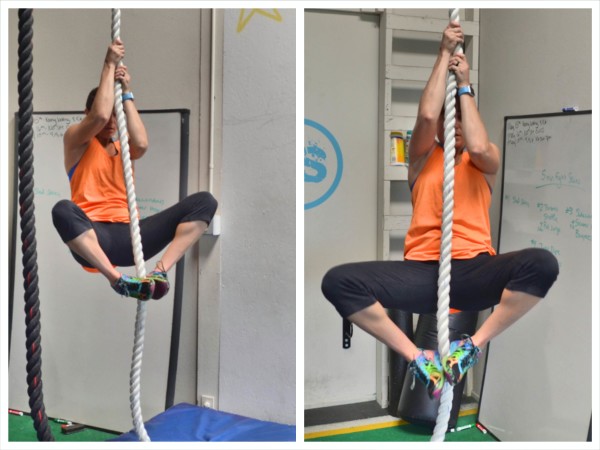
To do the Gym Class Lock, reach your arms up overhead to grab the rope. Then jump your feet up and grip the rope between your feet, squeezing your feet together hard.
Then push off your feet and reach your hands up higher. Holding tight to the rope, tuck your knees up and again squeeze the rope between your feet.
Continue this way up the rope, squeezing the rope between your feet and then using your legs to push you up as you then pull yourself up to reset your feet.
Again, this is the LEAST efficient of the foot locks and still requires a lot of upper body strength.
Basic Wrap and Lock – This lock is our favorite. It is easy enough to do and isn’t hard to redo if you happen to lose the rope as you are climbing. Plus it is super quick and really allows you to brake and use your legs to climb the rope.
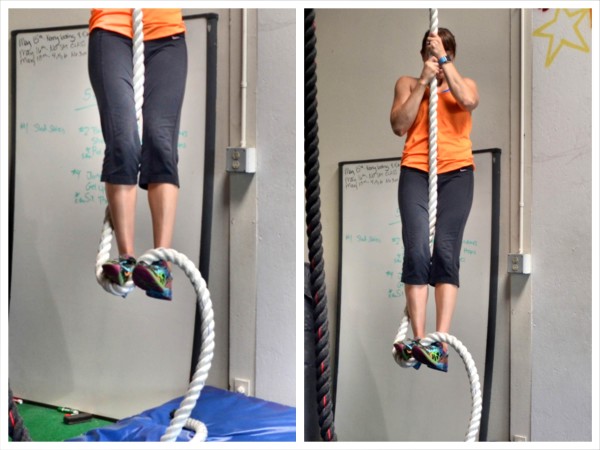
To do the Basic Wrap and Lock, reach your hands up overhead and let the rope fall down the center of your body. Tuck your knees up, and with your dominant foot, step down on the rope as you press up on the loose end with your other foot.
Your feet must be right together and even squeeze together as one presses up and the other presses down. This will “lock” the rope in place.
From here, push up and straighten your legs as you reach up overhead.
The more you tuck your knees up and then lock, the more you can push off your legs to help you climb.
Push off the rope lock and reach up overhead. Then tuck your knees back up and again lock the rope in place.
You can also do this basic wrap and lock with the rope outside your dominant leg instead of between your legs if that is more comfortable. The point is to stomp down on the rope with one foot as you press up and together on the rope with the other foot.
Stomp and Stand Wrap and Lock – This wrap and lock technique, uses less upper body strength then the Basic Wrap and Lock as long as you don’t lose the rope. If the rope comes unwrapped, you will have to use more upper body strength to re-wrap mid climb whereas it is way easier to grab the rope with the Basic Wrap.
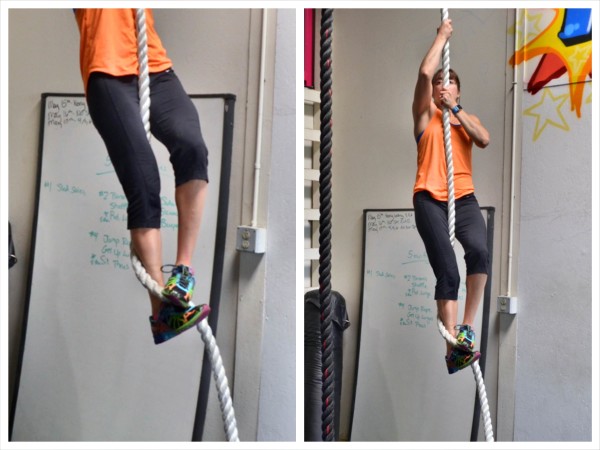
To do the Stomp and Stand Wrap and Lock, wrap your dominant leg in front and then in back of the rope so that the rope goes behind your thigh and then in front of your shin and on top of your foot.
Reach your hands up overhead and grab the rope. Pull up as you tuck your knees up with the rope wrapped around your leg. Then stomp down on top of the rope with your free foot, pressing the rope down into your bottom foot. “Stomp” and then straighten your legs and stand up so you can grab up higher on the rope.
Keeping the rope wrapped around your leg, release the top foot and again tuck your knees up. Clamp and stomp down with your other foot to stand back up and reach up higher on the rope.
Because this wrap can rub your leg more, you may want to wear pants or even switch to the Basic Wrap and Lock to come back down the rope.
Spanish Style Wrap and Lock – The Spanish Style Wrap and Lock is actually a really secure one and allows you to use your hips as you climb; however, if you lose the rope around your leg and it comes unwrapped, it isn’t as easy to get the wrap back and will require you to hold and use some upper body strength.
This wrap and lock has the same lock as the Stomp and Stand except, you will not squat to push up but instead lower your leg down in front.
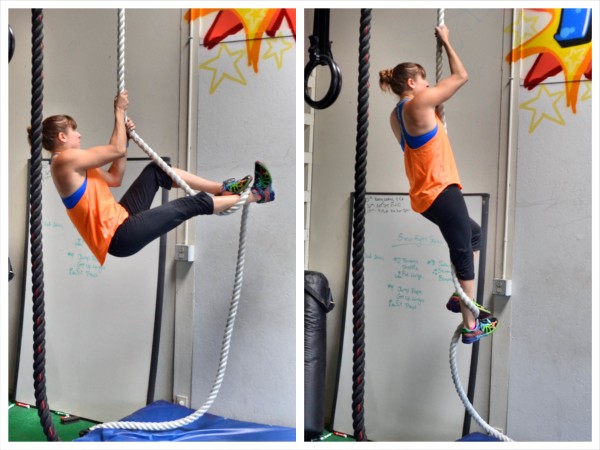
To do the Spanish Style Wrap and Lock, wrap your dominant leg in front and then in back of the rope so that the rope goes behind your thigh and then in front of your shin and on top of your foot like you did for the Stomp and Stand.
Reach your hands up overhead and pull up and tuck the knee of the leg with the rope up. Let the rope slid down your leg and then straighten that leg out with the rope wrapped around. Press your other foot down on top of the rope with your legs out in front of you almost as if you are sitting in the air.
Then with the rope secure between your feet, straighten your leg down toward the ground.
Once standing tall, reach your hands up and again tuck your knee up with the rope around your leg. Straighten your leg back out in front, lock down the rope with your other foot and then straighten your leg back down to the ground to come back up to standing.
Don’t worry if you lose the wrap. Just try to give yourself time to reset. If you really struggle with losing the rope, try the Basic Wrap and Lock.
Rope Climb Variations
While you learn how to use your feet to help you climb faster and more efficiently, you still want to build your grip, upper body and core strength. Below are some great Rope Climb Variations to help you build your upper body strength.
The first few exercises below are horizontal pulls or climbs to help you work to build your back, bicep and grip strength. They are a great way to build up to that vertical rope climb and even improve their pull ups.
The next few Rope Climb Variations are vertical pulls, including an Upper Body Only Rope Climb!
Row and Switch – This is a horizontal rope climb to build your back, bicep and grip strength. It is an Inverted Row Variations using a climbing rope.
You can make this move harder or easier by holding the rope up higher or lower and by how close to parallel to the ground you get when you perform the Row and Switch.

To do the Row and Switch, grab the rope with one hand above the other and walk your feet forward to an appropriate incline. Let your arms hang straight and engage your core to keep your body in a nice straight line. Press your chest out and engage your back.
Then drive your elbows down and back to row yourself up to the rope.
At the top, release the rope and switch your other hand on top.
Lower yourself back down and repeat, driving your elbows down and back to row back up and switch your grip. Do not let your hips sag or your back round. Keep your core engaged throughout the entire movement.
Bent-Knee Horizontal Climb – This horizontal climb is a great way to work on your upper body and core strength when climbing without having to pull up all your weight or even know how to perform a foot wrap.
The Bent-Knee Horizontal Climb is a great beginner rope climb and easier than the Straight-Leg Variation because you have to pull up less of your weight.
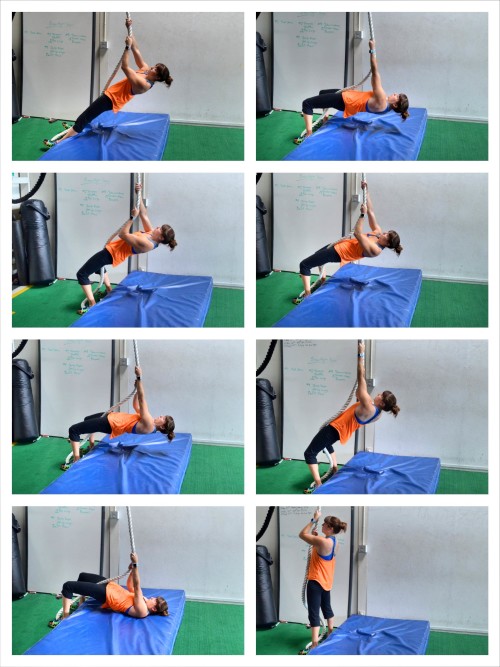
To do the Bent-Knee Horizontal Climb, start standing holding the rope in both hands at about head or shoulder height. Engage your core and press your chest out. Lean back and begin to lower yourself down hand over hand.
Bend your knees as you lower yourself down and keep your core and glutes engaged. Touch your back down to the ground if possible and then begin to climb back up hand over hand.
Do not let your hips drop down to the ground. Your butt can touch down but you don’t want your hips to sag as you climb. Climb back up hand over hand, keeping your core engaged and your chest pressed out.
Straight-Leg Horizontal Climb – To advance the Bent-Knee Horizontal Climb, you can straighten your legs. This will allow you to take on more of your bodyweight without having to wrap your feet to climb vertically.
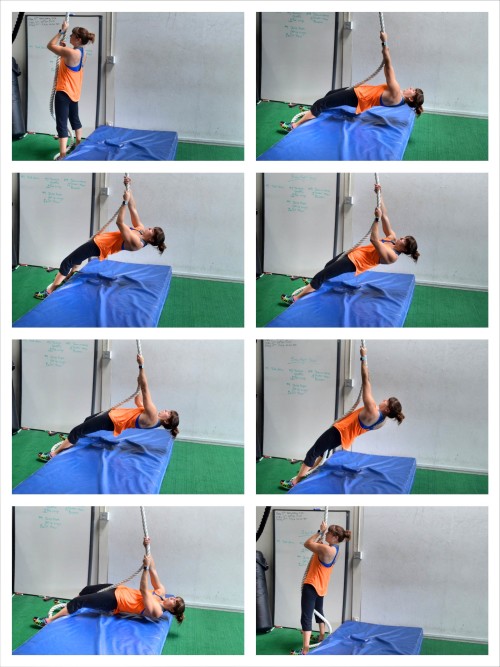
To do the Straight-Leg Horizontal Climb, start standing holding the rope in both hands at about head or shoulder height. Engage your core and press your chest out. Lean back and begin to lower yourself down hand over hand.
Keep your legs straight as you lower yourself down. Make sure you engage your glutes and core to keep your body in a nice straight line so your hips don’t sag and your low back doesn’t arch.
Lower yourself as close to the ground as you can. The lower you go, the harder the move will be.
Then climb back up hand over hand, keeping the core engaged and your legs straight.
Pull Ups/Jumping Pull Ups – Pull Ups are a great way to build your lat, core and grip strength with a vertical pull exercise so you can work up to the full rope climb.
To do the Pull Up using the Rope, reach your hands up to grab the rope one hand above the other. Then hang down. Depending on how high up you reach, you may need to bend your knees so your feet don’t touch down.
Press your chest out and, using your back and arms, pull your chin up over your hands.
Then lower back down and repeat.
Beginners who aren’t able to do a full Pull Up can start with Jumping Pull Ups. (Full Pull Ups shown in the top two photos and the Jumping shown in the bottom two.)
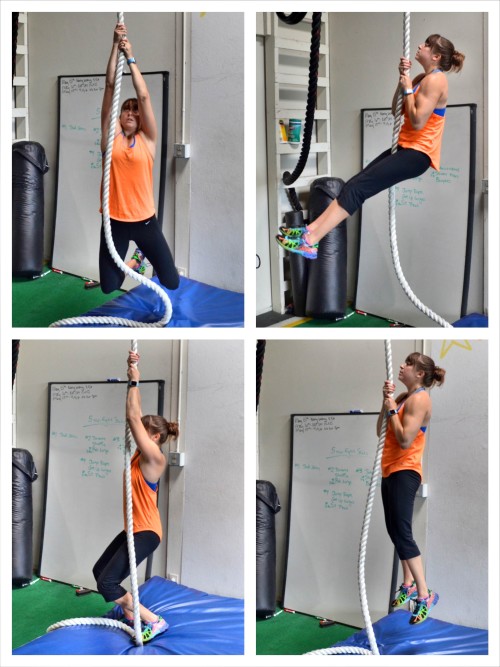
To do Jumping Pull Ups, reach your hands up to grab the rope at about the height of your head. Then bend your knees slightly to hang down. Using your legs as much as needed, jump up and pull down on the rope to pull yourself up.
Only jump as much as is needed to pull your chin up over your hands. Slowly lower yourself down and then repeat, jumping up.
The less you use your feet, the harder the move will be.
Foot-Assisted Climb – The Foot-Assisted Climb can be done with any of the wrap and locks discussed above. The point is simply to use your feet to help you climb so that your upper body doesn’t have to do all the work. This move will work your grip, upper body, core and even your legs, especially your adductors.
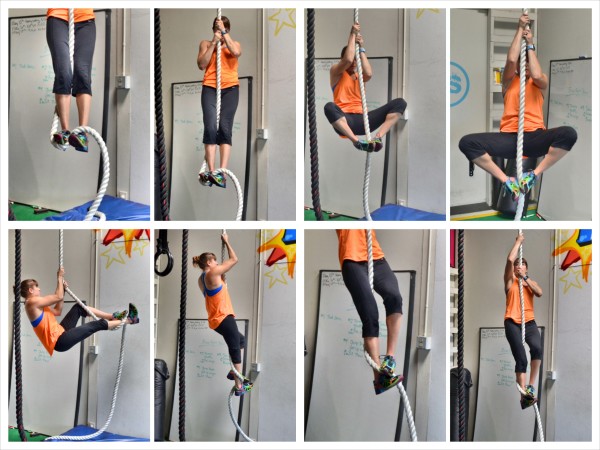
If you need more foot assistance, tuck your knees up higher and then push off your feet in the lock more. If you need less foot assistance, you don’t need to tuck your knees up as high and can use your upper body more.
Upper Body Only Rope Climb – If you want to make the rope climb even tougher, don’t use your legs at all and simply perform a climb with your upper body.
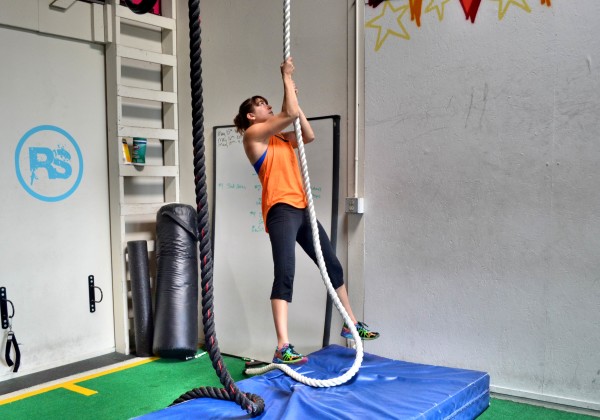
Start standing on the ground and reach up to grab the rope. Then climb up hand over hand until you reach the top!
Thicker Rope Climb – You can make any of these Rope Climb Variations more challenging by using a bigger rope. A thicker rope will challenge your grip even more to build your grip strength.
A stronger grip means climbing a rope will be easier and you’ll be able to lift more. You can only lift or pull what you can hold; therefore, you are only as strong as your grip!
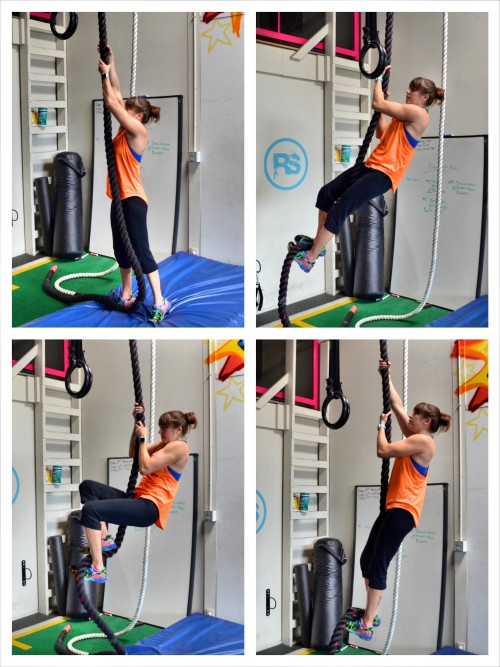
Use these Rope Climb Variations as well as the foot wrap and lock tips to help you master climbing a rope.
Whether you simply want to strengthen your upper body or you are looking to be able to climb the ropes at your first obstacle course or mud run, these tips will help you get there!
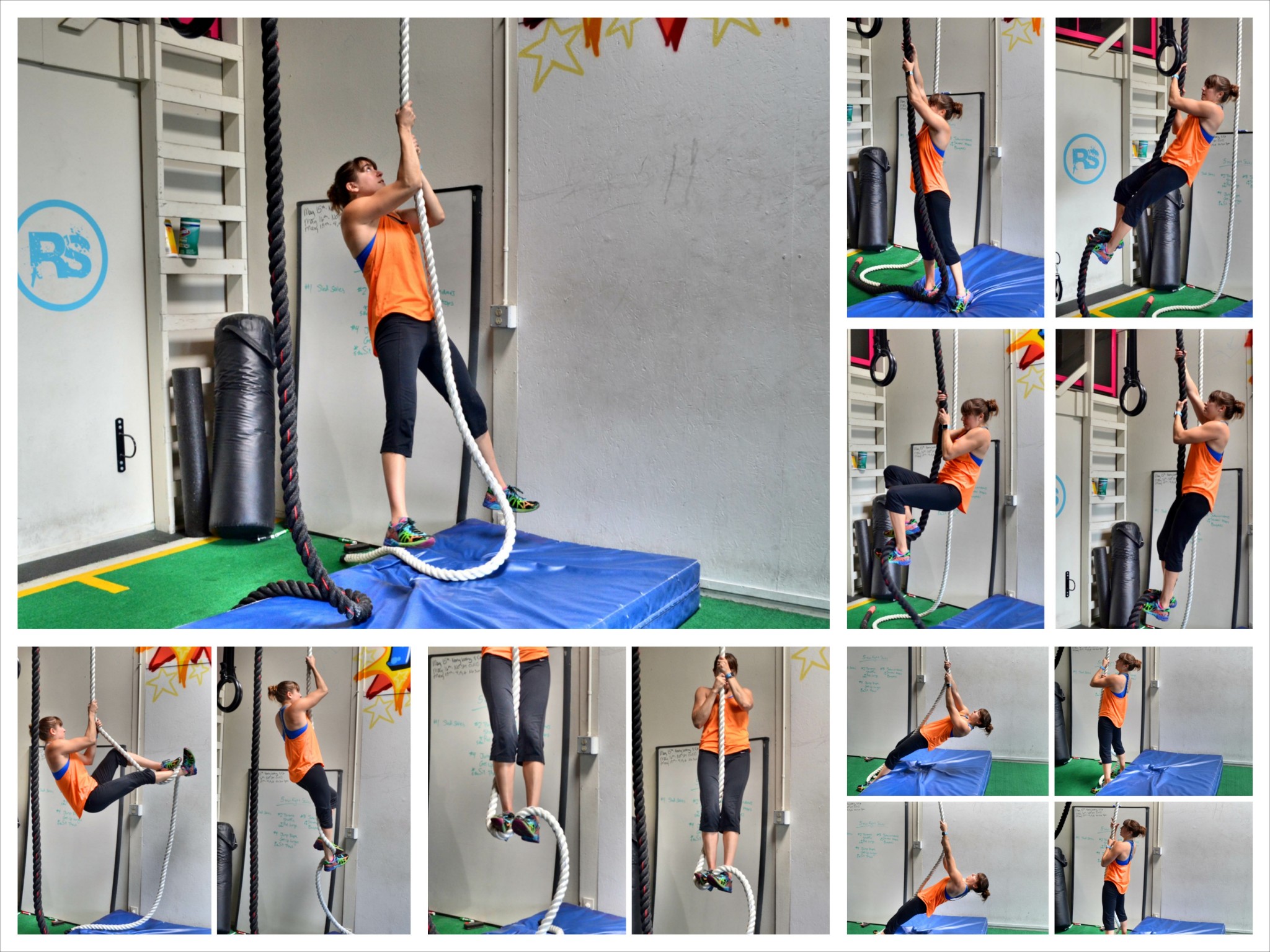


very nice and practice
Thanks!
BEST EXERCISE.BEAUTIFULLY EXPLAINED.LIKE IT.
Thanks! 🙂
What diameter rope should I purchase ?
Depends on how much you want your grip to suffer haha I have one that is an inch and one that is two inches. For anyone starting out, I would recommend the thinner one.
Wow this is a great article! How do you avoid rope burn on your hands?
Thanks! Oh gosh good question. Definitely don’t slide down. I have a ton of calluses so can’t say I really notice. Proper hand care around climbing and such is very important too so that you don’t get blisters. I use a file and some tackier lotion around workouts. Hope that helps!
Sounds good. What’s the best way to get down a rope then?
Hand over hand not sliding down. 🙂
Thank you so much for this post!!! Just ran a Spartan Race and was able to complete the rope climb using your basic wrap and lock technique. Couldn’t have done it without watching your video something like 20 times this past week.
Aw CONGRATS LIZ! So proud of you! Glad it helped and glad to hear you kicked some serious butt. Good luck on your next one! – Cori
Nice work out but what about climbing only with hands and without leg.
I demo that one too 🙂
Hi Cori, Great tutorial! I just started doing the preliminary exercises (assisted pullups and hangs), but started a twinge of elbow tendonitis. I’m taking a bit of a break. What other exercises do you do to compliment your training and avoid injuries?
Ok so you have a two-fold problem. You need to work on grip strength BUT your forearms are also tight. Start implementing these rehab moves – https://redefiningstrength.com/alleviate-wrist-and-elbow-pain-at-your-desk-with-these-10-tips/
Feel free to email me any time too Amy! – Cori